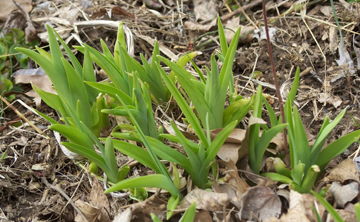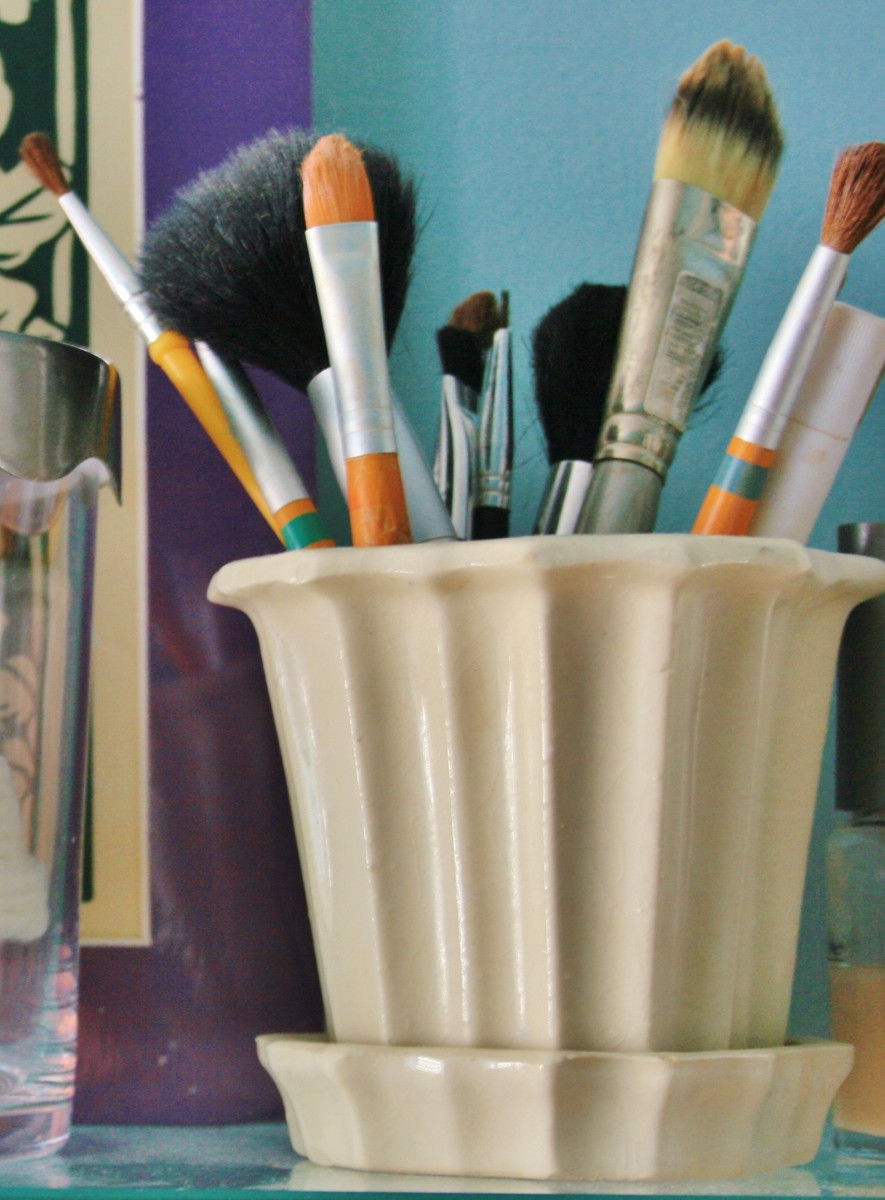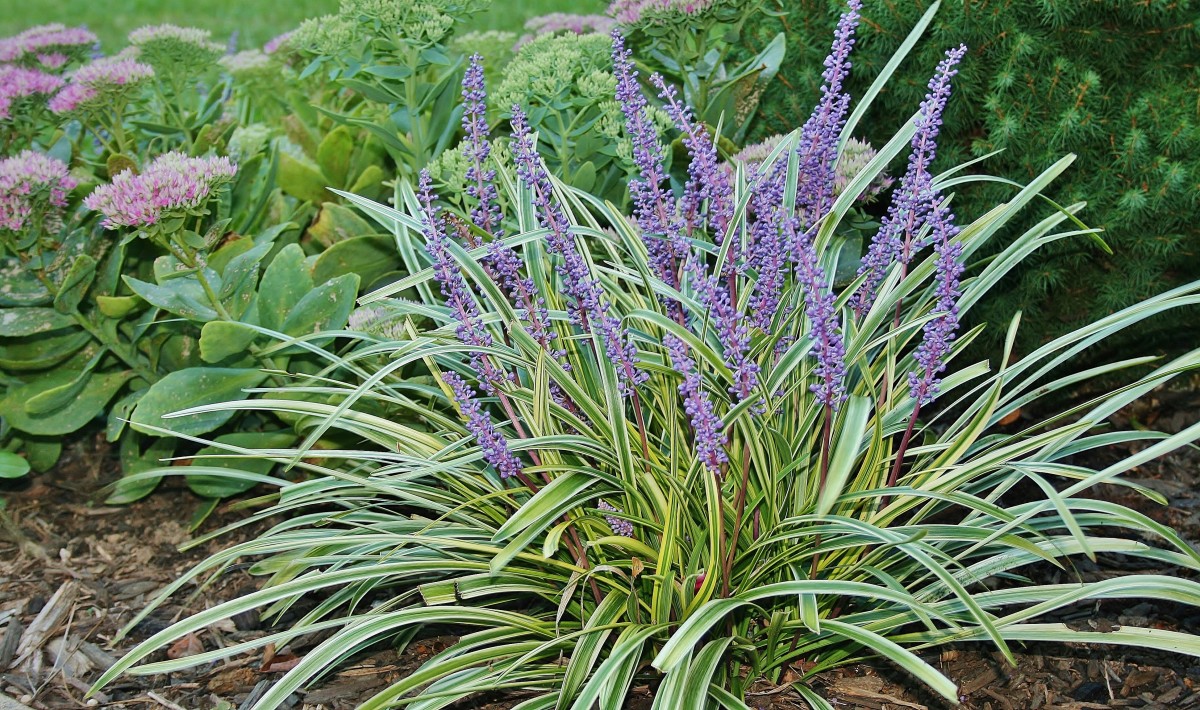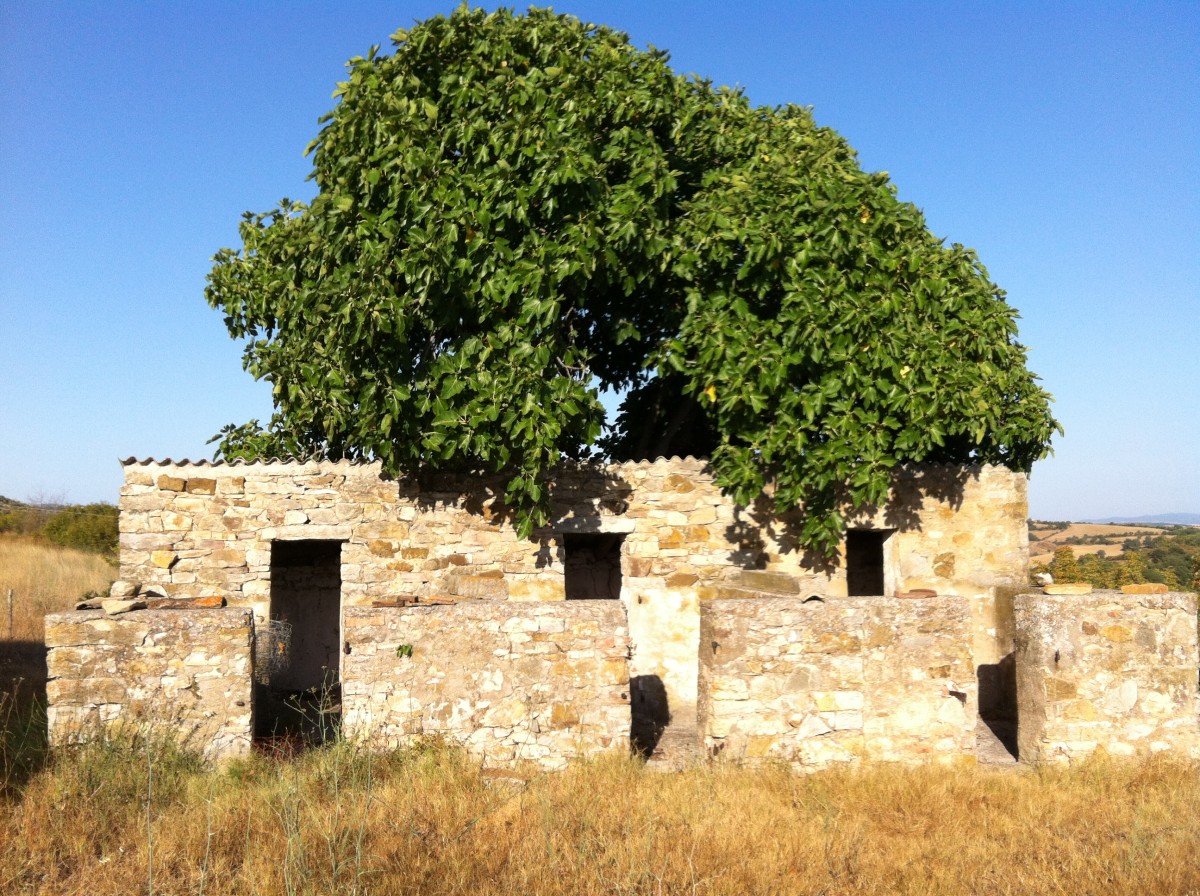The Top Ten Signs of Spring (Mid-Atlantic USA)
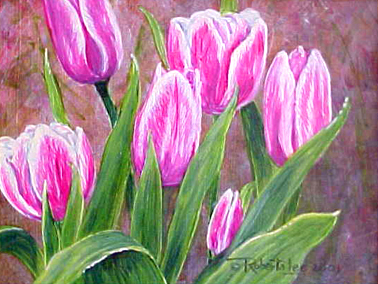
Planet Earth is a patchwork of microclimates, each one unique, and the one in which you live will determine not only when the season of plant reawakening we call “spring” will arrive, but how you will interact with the natural world around you.
There are many microclimates which do not experience spring in the classic sense, but where the shift between seasons is almost imperceptible. Yet even in the narrow equatorial belt that girds Mother Earth, plants and animals respond to environmental stimuli to determine when they will bloom, or when they will mate.
These changes flow into the way in which humans cultivate plants, whether the garden is for food or the sensory delight of flowering plants; watching, understanding and anticipating the cycles of nature are the keys to a productive farm as well as a gorgeous garden. Although today we often live profoundly indoor existences, seemingly far removed and in fact obvious to the rhythmus of the natural world, many people seek out ways in which to reconnect to it, of which gardening and an appreciation of nature are the two most prominent.
The center portion of the United States’ eastern region—in which I live—is blessed with a remarkably moderate climate, although it is prone to many variations of ‘normal.’ Summer drought, heavy spring rains and snowy winters are always a possibility that needs to be taken into account when planning a garden. And yet on average this area lies well within the narrow range of zones 5a through 8a, with the most extreme zones represented only by small portions of the entirety.
Spring arrives gradually, typically commencing with a full thaw in late February, highly variable weather through March, and a rather stately progression of increasingly warm days and mild nights from April through May. Summer-like highs (80’s and 90’s F) do not usually arrive until well into the month of June, although the record-breaking warm summer of 2011 proved those forecasts to be prone to Mother Nature’s whims.
Spring comes slowly at first, but once it commences the changes are perceptible from one day to the next. Here are two lists of the sure signs of spring’s arrival, five that take place in the natural world, and five you can look forward to in your garden:
Red-Winged Blackbird
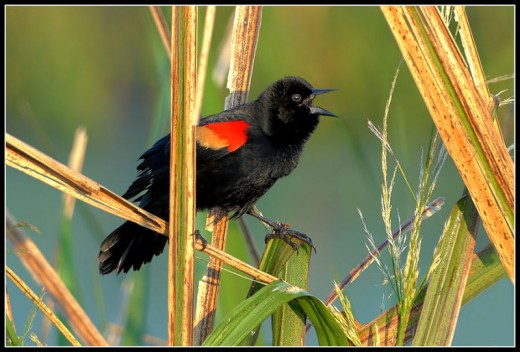
In The Natural World:
1. The arrival of red-winged blackbirds in wetlands. However small it may be, any area that features standing water in early spring will attract the highly territorial male red-winged blackbird (Agelaius phoeniceus ), a bird of distinctive plumage and song. Look for the glossy black males’ bright orange-red and yellow epaulettes, and listen for his loud conk-la-lee song. He’s warning other males off, and telling them that particular bit of swamp is already taken. The females cruise the wetlands after the males have fought matters out, searching for the male who owns the best real estate. The females are much less boldly colored than the males and are gray and brown striped, mid-sized birds resembling large sparrows.
Skunk Cabbage Spath
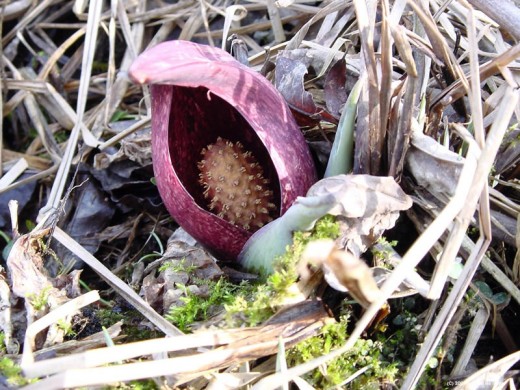
2. The emergence of skunk cabbage. If you spot a red-winged blackbird, look down at your feet. If the ground is wet, chances are you are near a patch of skunk cabbage (Symplocarpusfoetidu.). The purple-brown flowering spathes poke up from the mud well in advance of the tightly furled leaves. Skunk cabbage creates enough heat through a chemical process known as thermogenesis as it grows to actually melt its way through frozen ground. If the flowers are fully open, you may get a waft of the plants’ most distinguishing feature, its pungent scent, reminiscent of moldering cabbage or, in high concentrations, decaying flesh. The scent draws the pollinators the plant needs to reproduce: flies.
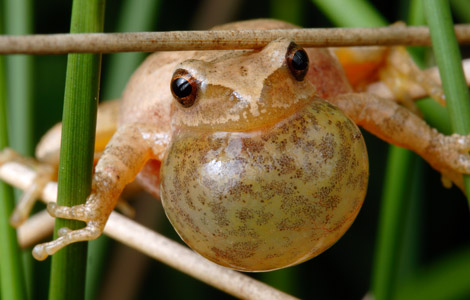
3. The awakening of amphibians. The smaller the frog, the quicker it will be to respond to the warming world and wake up, swim to the surface of the pond in which it has over-wintered in a state of semi-dormancy, and take a long look around. It will be a male, and he will be looking for love, and doing so in all the right places: Lakes, ponds both natural and manmade, ephemera ponds, even drainage ditches if they hold enough water to delight a small frog. Listen for the call of spring peepers (Pseudacris crucifer ) first; their collective thrill—like the jangling of a million tiny sleigh-bells—is one of the most welcome and distinctive sounds of spring.
My painting, "Still Chilly"
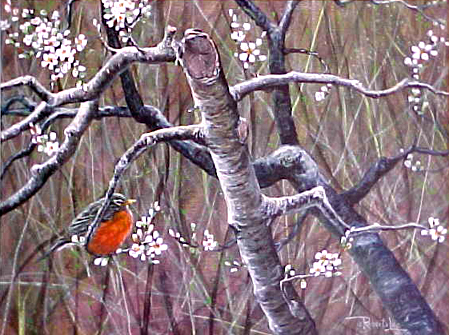
How well do you know the birds?
4. The foraging of American robins in your yard. Contrary to popular belief, American robins (Turdus migratorius) are not consistently migratory and during most winters a large part of the indigenous population remains in place or shifts slightly to the south. Only in very harsh winters does the native population migrant in numbers from the northern states. They are inconspicuous tenants during the cold months, however, because their winter diet switches from the earthworms you see them conspicuously tugging out of your yard in the spring and summer to the wild fruit they find in woods and thickets. The clear, musical call of the male American robin is a familiar sound throughout this birds’ wide range, and is often phoneticized as “cheerily, cheer up, cheer up, cheerily, cheer up.”
Northern Cardinal
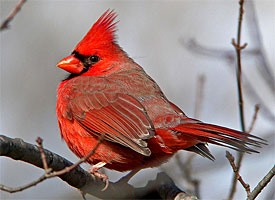
5. The Dawn Chorus. It begins with the call of one or two hardy males, most often Northern Cardinals (Cardinalis cardinalis), and each day at the first blush of dawn it grows louder and more complex, as other species join the symphony. The songs are territorial, and each bird is trying to out-sing the others of its species, and the effect is one of the true glories of the natural world.
The Dawn Chorus
Witch-Hazel, Helebores & Forsythia
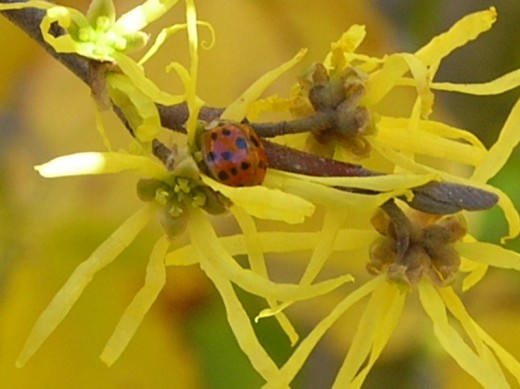
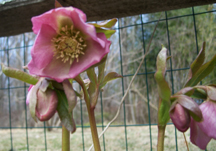
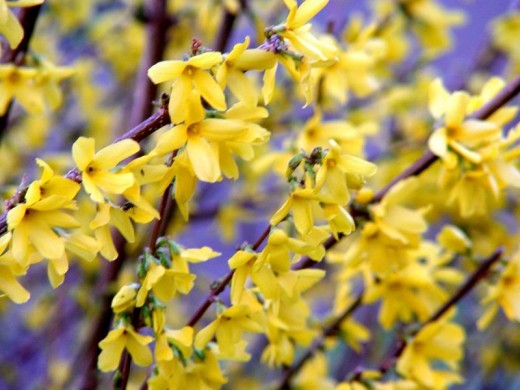
In The Garden:
1. The blooming of witch-hazel, hellebores and forsythia. These are the first of our garden favorites to bloom and mark a true tipping point, as winter’s grip is irrevocably loosened. Witch-hazel (Hamamelis ) species are a native North American family of small under-story trees whose spidery, creamy yellow flowers open very early in the spring. Helebores are another early blooming group of perennial plants but are low growing, with delicate, nodding flowers in soft pastels and deeply lobed, glossy leaves; all parts of hellebores are highly toxic and the plant should only be handled if wearing gloves. Forsythia is an old fashioned shrub that has recently been much hybridized and improved from its heritage cultivars, although the wonder of a large, unruly clump of vintage forsythia in full bloom remains an unchallenged harbinger of spring.
My painting, "Awakening"
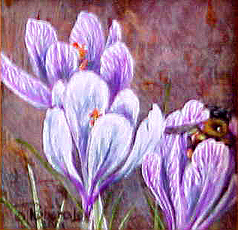
2. The earliest spring bulbs: Crocus and daffodils. We plant them in the fall and their evolved ability to withstand the bone-dry Mediterranean summer of their origins provides them the stamina to over-winter in much more northern climates. Their colors—soft purple, yellow, creamy white—have become the signature colors of spring.
My painting, "All Yellow"

3. The rapidly swelling buds of rhododendron, azalea and magnolia. Each day their buds plump a bit more, and we watch in anticipation of the amazing display ahead. All are widely hybridized genera, with native species occurring widely throughout the Northern hemisphere.
My painting, "Elusive"
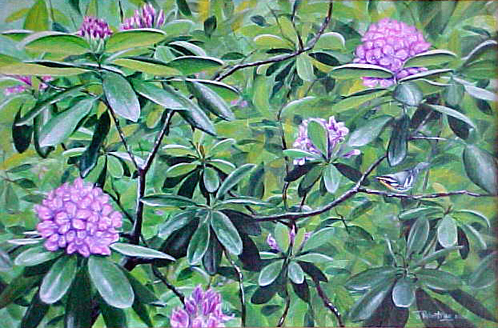
Cherry Blossoms
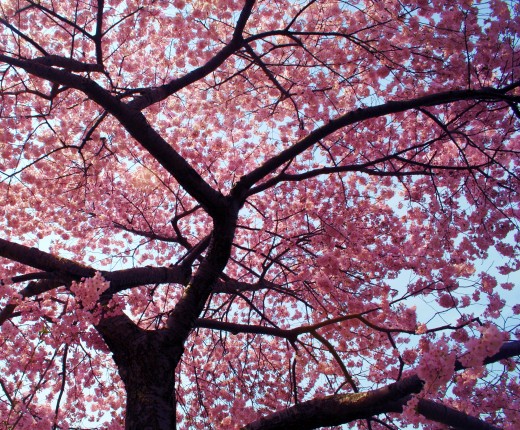
4. Cherry blossoms. A venerable Japanese tradition that has found a home in the United States, viewing the blossoming of Prunus serrulata is one of the most satisfying rituals that mark the turn of the seasons from winter to spring. Their lovely pink flowers reawaken the world to color after the long hiatus of winter’s grays and browns, and the fleeting period of that bloom reflects the transitory nature of the season.
5. The optimistic noses of perennials poking up through partially frozen soil. Daylilies (Hemerocallis species) are among the first perennials to show growth in the spring, other early risers include Lungwort (Pulmonaria ), Bee Balm (Monarda ) and the many varieties of Spiderwort (Tradescantia ). Walking through our gardens, we see them as the bravest our good friends, returning into our lives, returning into life.
Spring always seems to me to be the most transitory of the seasons, existing in some speeded up time warp. Partly that’s because of how busy a time it is in the garden, partly because I’m looking forward to the next great wave of blooming, as daylilies give way to perennial geraniums, monarda, baptisia, tradescansia . . . and to summer !
(I am an artist and the author of the Suburban Sprawl series of novels as well as two nonfiction books. Find out more about my work at RobertaLeeArt.com.)
Copyright © Roberta Lee 2012. All rights reserved.
Emerging clump of daylilies
